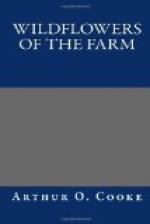In the farmhouse garden, however, it is certainly a weed—a plant in the wrong place. We see that at once. Close to the hedge are some gooseberry and currant bushes, and into these the Bindweed has climbed. The Bindweed’s stems are twined round the stems and branches of the bushes till they are almost hidden by it, and are bent down by the weight.
[Illustration: Large bindweed.]
The Bindweed climbs, as we see, by twisting its stem round the tree to which it clings; but though it is a climbing plant its stems can grow for a foot or more from the ground without support. Some of the shoots of the Bindweed are two or three feet away from the stems of the fruit bushes, but they have grown unsupported till they could reach an overhanging bough and cling to that.
Every now and then, Dan, who looks after the garden when he has time, cuts oft all the Bindweed close to the ground, and pulls some of it up by the roots; but fresh shoots soon appear again. It is of little use to dig up the ground near the bushes, for the Bindweed is twisted all among their roots.
You think the Bindweed and the Traveller’s Joy beautiful flowers, and so they are. At the same time these plants are far more troublesome and dangerous weeds than the Stinging Nettle. Nearly all plants that cling to other plants do harm; they prevent the stems and boughs to which they cling from swelling freely. See how tightly the Bindweed stems are twisted round the boughs of this currant bush. Ivy, Bindweed, and other clinging plants often kill or seriously injure valuable trees in this way.
CHAPTER V
CLOVER
I said all I could to make you admire the Nettle, and to see what a handsome and even useful plant it is. I am afraid, however, that you do not care much for it; I do not see that any of you have gathered a handful to take home. When we go in to dinner presently, if Mrs. Hammond were to say, “Will you have green peas or nettle-tops?” I believe you would all say, “Peas, if you please!” So we had better look for a flower that you may like better. We will go to Ashmead, where the cows are grazing, and will find some Clover.
Mr. Hammond grows Clover in some of his fields every year. Those of you who have been at Willow Farm before, and have walked about the farmer’s fields, know this, for we saw the bailiff sowing Clover broadcast. Besides the fields of Clover, however, there is always plenty of it growing among the meadow grass. We find some directly we go through the gate into Ashmead. It is a plant with a bright purplish-red blossom. Let us sit down and examine it carefully.
The blossom is a little knob, or ball of colour, almost round. It is made up of a great many little purple stalks, standing upright and very close together. Pull a few of these stalks from the blossom and put their lower ends between your lips. They are quite sweet like sugar. Nearly all flowers contain honey, or rather nectar of which the bees make honey. Some flowers have much nectar, some less, and some have none at all; the Clover contains a great deal.




